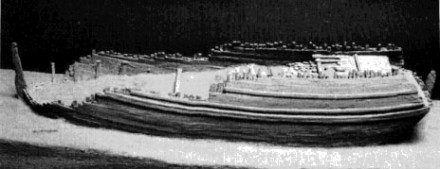History
A known wreck
The port of Dalarö near Stockholm had been a trading port from the close of the 15th century, and possibly even earlier. A wreck on the bottom of this harbour had been known to locals for a long time. It was called Saltskutan (Salt Ship) after its supposed cargo when it was lost. This suggests a long oral tradition. Another local tradition tells that the ship caught fire while the crew was ashore drinking beer.
An inspection showed that it possibly concerned a wreck from the lat 17th or early 18th century. It was a relatively large vessel with a partly preserved cargo of sawn lumber. It was obvious that the ship was badly damaged by fire.
Research was carried out on the wreck from the 80's of the 20th century. The wreck was dated using dendrochronology. The ship's hull was of oak but could not be analyzed. Parts of the timber cargo could be analyzed it was dated to around 1700. This led to archive research being done to determine the identity of the ship.
Archive research
A ship called the Anna Maria appeared in the Stockholm archives concerning a lawsuit in 1709. A fire broke out on board the Swedish flute-ship Anna Maria from Stockholm while the crew was away from the ship. The destiny of the ship was Lisbon, Portugal, but it was caught in ice and had to wait in Dalarö harbour for better weather.
Most of the crew members had been sent home. A few men remained on board the Anna Maria to keep watch. The winter of 1708-09 was extremely cold, and the watch crew most probably suffered from the conditions; a fire was kept burning in the galley. One day crew members from a neighboring ship were offered a meal on the Anna Maria. Afterwards, the visitors and some of the Anna Maria's watch crew went ashore to drink ale, as the ale on board was frozen. While they were away, the ship caught fire and there was nobody on board to do anything about it.
Cargo
The researchers concluded that this ship is a very likely candidate for the wreck in Dalarö harbour. A list of the cargo was also found in the archives which corroborates this. While waiting in the ice the ship contained 48 dozens of pine planks, 46 sheets of copper, 1360 kilograms iron in bars and 116 tons steel packed in 136 barrels. Dives have shown that this type of cargo is indeed present in the wreck.
Background
More information on the ship was found in the archives. The Anna Maria was a Swedish owned flute ship built in Amsterdam around 1693. In 1698 the ship was expected back from the salt port of Torre de la Matta in eastern Spain but she was delayed because of an incident with a so-called Barbary pirate vessel, which was described in correspondence between the Swedish consulate in Lisbon and Foreign Affairs in Stockholm. The Anna Maria and another Swedish merchant vessel, the Stora Christoffer from Karlskrona, had been attacked by North African pirates. The consulate reported that she 'defended herself bravely against two large Turks who dishonourably turned tail'. These pirates, all though they usually came from the area of Algiers, were often called 'Turks' by Europeans. As a result of this incident, Jürgen Corneliussen, the captain of the Anna Maria, was wounded so gravely that he died in Cadiz (see Ahlström 1988, Diplomatica Portugallica vol. 14, report by Nicolas Simons to Stockholm, 16 December 1697).

Description
Tonnage : 274 last
Archive studies revealed that the ship was build in Amsterdam in 1693 for a consortium of 15 Swedish shipowners. Originally she was called Juffrouw Anna Maria.

| Master | Philip Boivie (Philip Bewe) |
|---|---|
| People on board | 22 |
| Length | 125 feet (38.1 m) |
| Width | 26 ½ feet (8.1 m) |
| Beam | 27 ½ feet (8.4 m) |
Status
No full-scale excavation of the site has been carried out but the presence of the wreck and local knowledge spurred archive research and survey dives.
The ship caught fire during the winter of 1708/09 and sank in the harbour of Dalarö. The survey dives have revealed that the stern is almost completely destroyed. The bow and front parts have been partly preserved. A part of the cargo of planks can be easily seen.
It could be observed that the upper layer of the cargo in the wreck consisted of timber of Swedisch pine. In the hold, planks, copper and barrels have been found. No trace of the iron bars has been found. Large parts of the bottom are covered by an unidentified concretion, which may be remains of oxidised iron.
References
- Flute ship Anna Maria.
- Britt-Marie Petersen.
The Dutch fluitship Anna Maria, foundered in Dalarö harbour in 1709. - Criminal case records of the Stockholm Municipal Court, 6 May 1709 (SSA) and the investigation records of the kämner court, 19 March 1709 (SSA).
- Excerpts of minutes from the archives of Notary Adrian van Zanten, 29 November 1694.
The Amsterdam Notarial Archives (Gemeentearchief, Amsterdam). - Christian Ahlström (1988).
Diplomatica Portugallica vol. 14. - The Finnish Academy of Science and Letters (1997).
Looking for Leads.
The Finnish Academy of Science and Letters.